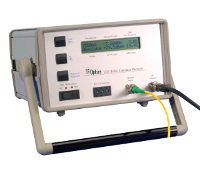** OMI Devices & Technical Support - No Longer Available / Discontinued **
The manufacturing entity of the FOS 1000A & FOS 1200A OMI devices has discontinued this product line. New devices and related support for existing devices (repair and calibration service) are no longer available. This page is intended as a resource of information about the technical topic of OMI along with providing OMI device data sheets for reference.
 |
|
Why Measure Optical Modulation Index?
With CATV service providers increasing the number of services offered to their subscribers, the optical networks need to be optimized for peak performance. If not, the risk of losing revenue is increased, as unhappy subscribers now have the option of switching to Satellite, Telco, and other internet services. By setting proper OMI, operators now have a simple, yet cost-effective solution for ensuring maximum performance, while saving their technicians a significant amount of time.
The Challenge
Before any laser transmitter is used in a system, it goes through several processes and specification setting procedures which introduce many variables. All of these procedures are prone to inaccuracies that, in the end, may add up to a major shift in performance. Until now, the tasks of setting proper OMI required significant investments in laboratory-grade equipment, as well as time-consuming calculations and manual adjustments. Furthermore, any time a single variable changes, the entire process must be repeated – not an ideal scenario! Furthermore, just a small change in any variable can be the difference between great service and marginal service to the subscriber.
The Solution
The FOS 1000A and FOS 1200A from M2 Optics are the only instruments available that help you easily measure and set proper OMI, without wasting valuable time and money. Proven at the largest CATV companies and equipment manufacturers, this instrument is useful for a variety of applications, allowing technicians to work smarter, not harder.
Improve Laser Transmitter Performance
The FOS device is the fastest, most effective tool available for optimizing laser transmitter performance in CATV systems. With a unique ability to measure OMI, headend technicians can ensure that more transmitters are operating at peak level in less time.
Traditional methods for determining OMI not only require expensive lab-grade equipment, but also a highly experience professional to perform the manual trial-and-error tasks. Since several variables can and do affect OMI, this is a time-consuming process, resulting in as much as an hour or more per transmitter to complete.
When using a DOCSIS-compatible FOS device, all of these variables are taken into account automatically, eliminating manual calculations. Easy to use, technicians of all experience levels can support the effort to enhance system performance and retain subscribers.
Applications for CATV & Multi-Channel Operators:
- Laser transmitter setup
- Laser transmitter maintenance
- Network troubleshooting
- Performance benchmarking
Applications for CATV Equipment Manufacturers:
- Laser transmitter development & manufacturing
- Quality assurance testing
Importance & Definition of Optical Modulation Index (OMI)
What is Optical Modulation Index? The primary factors in the performance of optical communications systems and specifically laser transmitters are Optical Power and Optical Modulation Index (OMI). The OMI must be set properly to achieve optimum Carrier-to-Noise Ratio (CNR) while avoiding unacceptable large non-linear distortions and threshold clipping effects. Static clipping behavior increases the lasers non-linear distortions and imposes an upper limit on its channel capacity.
The mathematical calculation of CNR for a multi-channel carrier system is a statistical calculation comprised of several variables: OMI (m), video noise BW (B), receiver photocurrent (I), receiver noise equivalent current (N), and laser Relative Intensity Noise (RIN): CNR=(m*I)2/[2B(2qi+N+(RIN*I2)]
As you can see, OMI (m) is a key variable along with optical power in the CNR equation. Therefore, to optimize the system, it is vital to get as much optical power from a laser as the result of setting OMI to the optimum level.
Since determining the optimal setting for a laser transmitter requires performing multiple calculations each time a variable changes, using an OMI device that can quickly and automatically measure OMI saves significant time for engineering teams.
Key Benefits of OMI Devices
| Optimize Performance |
Laser transmitter operates at peak level |
| Saves Money | Eliminates expensive equipment traditionally required Identifies potential issues before problems occur in field |
| Time Savings | Reduces time spent setting proper OMI by 85% Eliminates manual calculations and repetitive tasks |
| Performance Benchmarking |
Useful for determining performance benchmarks |
| Network Troubleshooting | Helps to identify issues and their possible causes in the network |
| Transmitter Mfgr Dev & QA | Ensures equipment is operating as expected before being shipped |





